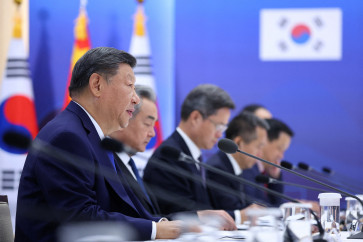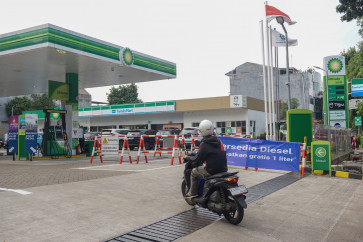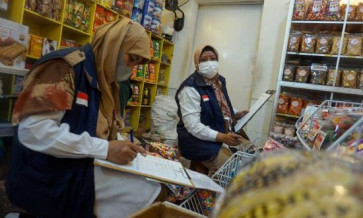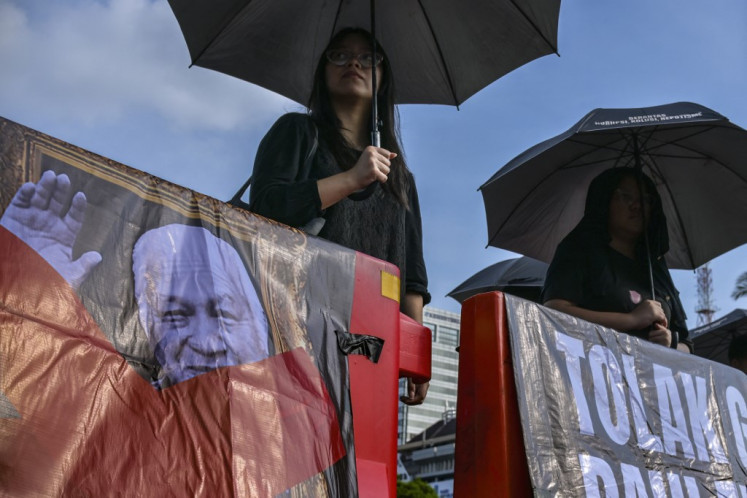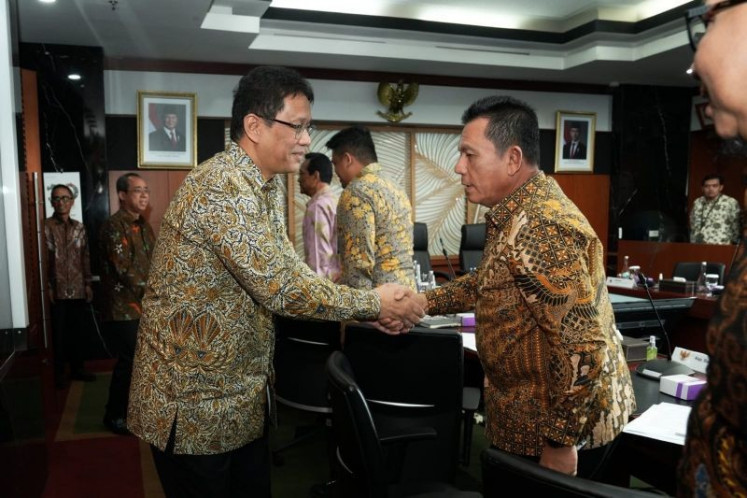Popular Reads
Top Results
Can't find what you're looking for?
View all search resultsPopular Reads
Top Results
Can't find what you're looking for?
View all search resultsSei Pinang – a haven for gold excavators
Mount of danger: The dumping of material from gold exploration seen here near the Kapuas River, can have a dangerous ecological effect on both the river and the forest
Change text size
Gift Premium Articles
to Anyone
M
span class="caption">Mount of danger: The dumping of material from gold exploration seen here near the Kapuas River, can have a dangerous ecological effect on both the river and the forest.
Bordering the Kapuas Hulu and Kapuas Hilir Rivers in Central Kalimantan, Sei Pinang — belonging to Mandau Talawang subdistrict and Kapuas district — is a lesser known village in Palangkaraya because of its geographical remoteness from the capital of Central Kalimantan.
To reach this village, one has to first endure a four-hour bumpy drive (due to uneven roads) from Palangkaraya to Sungai Hanyu (Hanyu River) and then take a klotok (traditional boat), commonly known as a taksi sungai (river taxi), for about one-and- a- half hours.
Historically, Sei Pinang’s rich natural resources once attracted the Dutch and Japanese government, which is why these two countries occupied the village for quite a long time. The chiefs of Dayak tribes Timbang and Kurih were strongly against this occupancy and defended the village from being exploited by other countries.
Hoping to strike it big: Workers use simple machinery in the search for gold.
Due to their bravery in opposing colonialism at that time, they were dubbed singa (lion), hence singa timbang and singa kurih, which later became the names of streets in Sei Pinang.
Despite the village’s reclusive location, an increasing amount of people from the greater parts of Palangkaraya including Banjarmasin (South Kalimantan) and Sampit (East Kalimantan), flock to this village to work at rubber and oil palm plantations, to sell everyday items in small kiosks and to excavate gold and intan (raw diamonds).
Most newcomers, however, decided to settle in Sei Pinang because the village, apart from its tranquility and pristine rows of leafy forests, is surrounded by wooded riverbanks that are rich with gold deposits. Thus, almost 80 percent of the residents of Sei Pinang hail from different parts of Kalimantan.
Ara L. Sindekh, 52, said he first came to Sei Pinang in 1985 to work as an intan excavator before he began working at an oil palm plantation. After he married a local Sei Pinang woman, he decided to make the village his permanent home.
Nevertheless, due to having experienced a light stroke, Ara has opted for early retirement. “My ailment impedes my speech production and my ability to walk steadily. Moreover, I suffer from memory lapses that make it difficult for me to recall what I’ve said”, he said.
In the 1980s, Sei Pinang was well-known for its abundant intan deposits. However, excessive excavation activities at that time almost used up these deposits, compelling the local people to seek other possible resources deep down in the ground.
Golden area: Sungai Hanyu is a small village in Central Kalimantan that connects travelers to Kapuas Hulu and Kapuas Hilir.
Since it was later found that the areas around Sei Pinang also contained rich gold deposits, the locals have begun to excavate it to make ends meet. Excavation, which takes place in the deep leafy forest, is done with simple tools, rather than high-tech machinery. A diesel engine, diesel fuel, extra-large hoses, iron pipes and extra large plastic pipes are also used. Mercury is also needed to cleanse and purify the would-be gold from the sand and mud.
After excavation of the land at required depths, the ground water that is mixed with mud and clay flows through the hoses and pipes and is deposited in the Kapuas River.
The excavators, however, seem unaware that in the purification process, the mercury could spill into the peaty soil, which absorbs it and mixes with the ground water, thereby contaminating it.
Attempts to find areas in the forest that contain gold deposits are not always easy. Santo, a young Sei Pinang resident who excavates gold daily, said he had struggled to walk miles in the jungle simply to avoid being bitten by poisonous snakes. Though he was once bitten by a snake on his ankle, he continues to maintain high spirits so that he can continue to work in the jungle.
Inhabited mostly by the Dayak tribes that practice the Hindu Kaharingan religion, Sei Pinang is one of the most remote villages in the Indonesian province, where the people still actively preserve their local Dayak language. The local villagers speak different forms of the Dayak language at home and in school.
During wedding rituals, for example, all communities are required to use the Dayak language. Similarly, in school, students converse in the local language, although they sometimes mix it with Indonesian when communicating with their teachers during lessons.
Main transportation: Local residents take the traditional klotok (river taxi).
An SD 2 Sei Pinang teacher, Suwardhy Undal, who has taught in Sei Pinang for about 32 years, said speaking in the vernacular language is one form of preserving Dayaknese traditions and the linguistic heritage passed down by his ancestors.
“If we don’t speak our mother tongue, who else will continue our Dayaknese traditions and identity?” he said proudly.
— Photos by JP/Setiono Sugiharto





